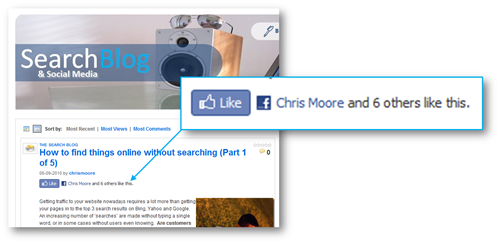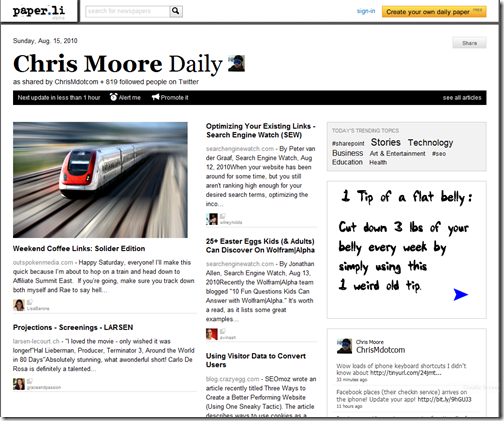How to find things online without searching (Part 2 of 5)
Following on from part 1 in this mini series, part 2 focuses on how ‘liking’, ‘tweeting’, ‘stumbleupon’ and other social voting mechanisms makes it easy for people to find fresh, personalized, relevant content without having to type a single search word.
Do your customers ‘like’ your content?
When I posted part 1 of this series I added the Facebook like button code which enables people to ‘like’ the post, notify their Facebook friends and see which of their friends also likes it – all with just ONE CLICK!…
What’s great about this button for discoverability of web content is that every time someone clicks on it, their friends are notified within their Facebook newsfeeds…
So by making it easier for visitors to your website to ‘like’ your content, your pages will be displayed as ‘recommended’ to thousands of your customer’s friends – without the need for them having to perform any searches. If you haven’t added the simple Facebook like button code to your website, get it done as soon as possible! Same advice for the recently (last week) launched Twitter ‘tweet’ button.
Of course, it’s not only Facebook which offers users the ability to tag and recommend content, this recent blog post from Mashable shows the most popular social networks for sharing content across the web…
Mobile voting of content
It is also unbelievable (or perhaps dangerously) easy to ‘vote’ for content on mobile devices and share the recommendation virally with a huge number of people across numerous social networks, in just a few taps of the screen. This diagram shows what happens every time I ‘tweet’ a news article from iPhone NetNewsWire RSS news reader…
Personalised Newspapers
The ease of ‘liking’ content has resulted in a huge increase in the number of people sharing content on an increasing amount of diverse topics. This means that there is enough data to produce a personalised feed of news based on connections you have in social networks, or based on a chosen subset of a particular network (which may or not be a part of).
Paper.li is a service which generates a daily newspaper of the latest content based on the links being shared most by your Facebook or Twitter connections. Here is MY daily newspaper based on the people I follow on Twitter (most of which are Search/Social Media related)…
Even though my Twitter feed only contains tweets and links, this site shows the actual content from the links, including headlines, images, videos and summary paragraphs. This is truly a personalised, free, daily newspaper which presents me only with information relevant to my interests, based on what my trusted social network is discussing and sharing.
If are not part of a social network of experts on a particular topic, you can simply generate or read an existing newspaper based on a particular hashtag, or based on another twitter user. Here is the daily newspaper for the #bing hashtag…
Considering that all I entered to generate this, the results are incredibly accurate and relevant! Note the first graphic which is a pie chart showing search engine share between Google, Bing, Yahoo and other search engines.
Taking the personalised feed of information one step further is this incredible innovative Flipboard product, which takes full advantage of the iPad interface…
So What?
In conclusion… the variety of web sharing mechanisms is increasing, sharing of all different content types if becoming increasingly easier and automated technologies for consuming content are becoming more sophisticated. If you are not tracking which of your pages are being shared, tweeted, liked or socially voted in some other way – you need to start. I will try to cover social sharing monitoring technologies in a future posts.
Author: Chris Moore is a program manager from Microsoft working on Search Engine Optimisation. Follow him on Twitter




